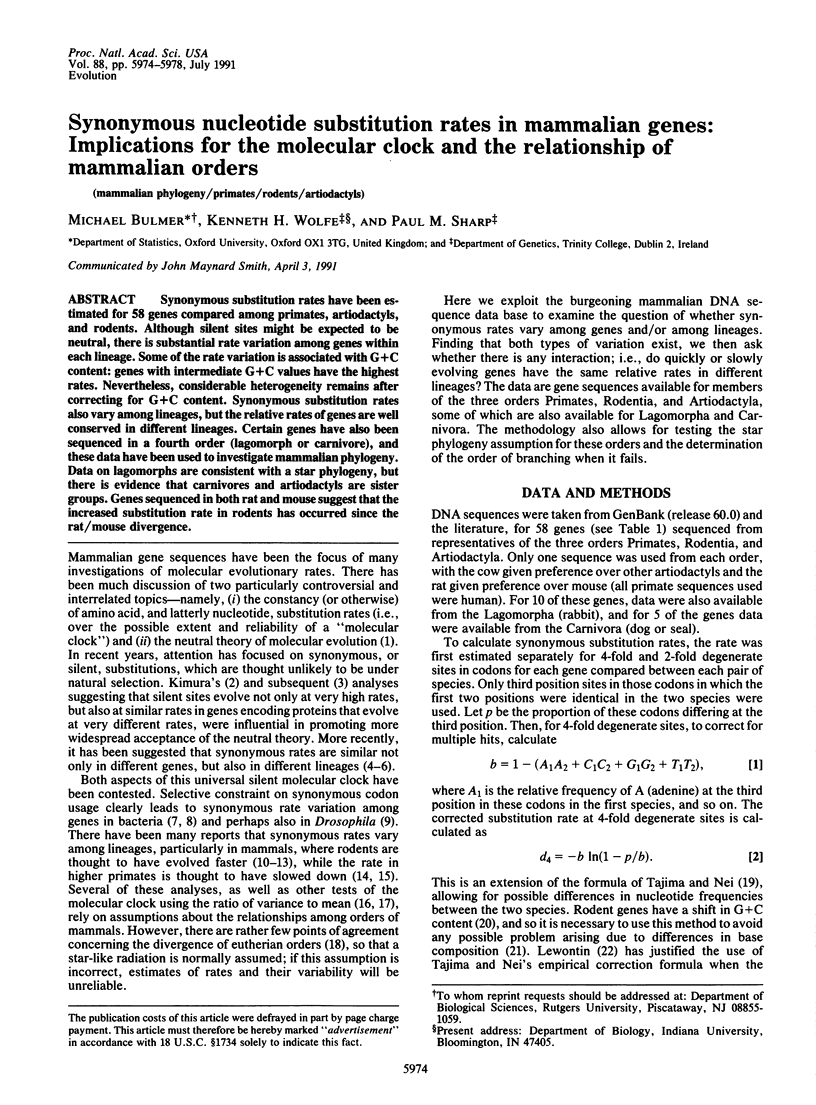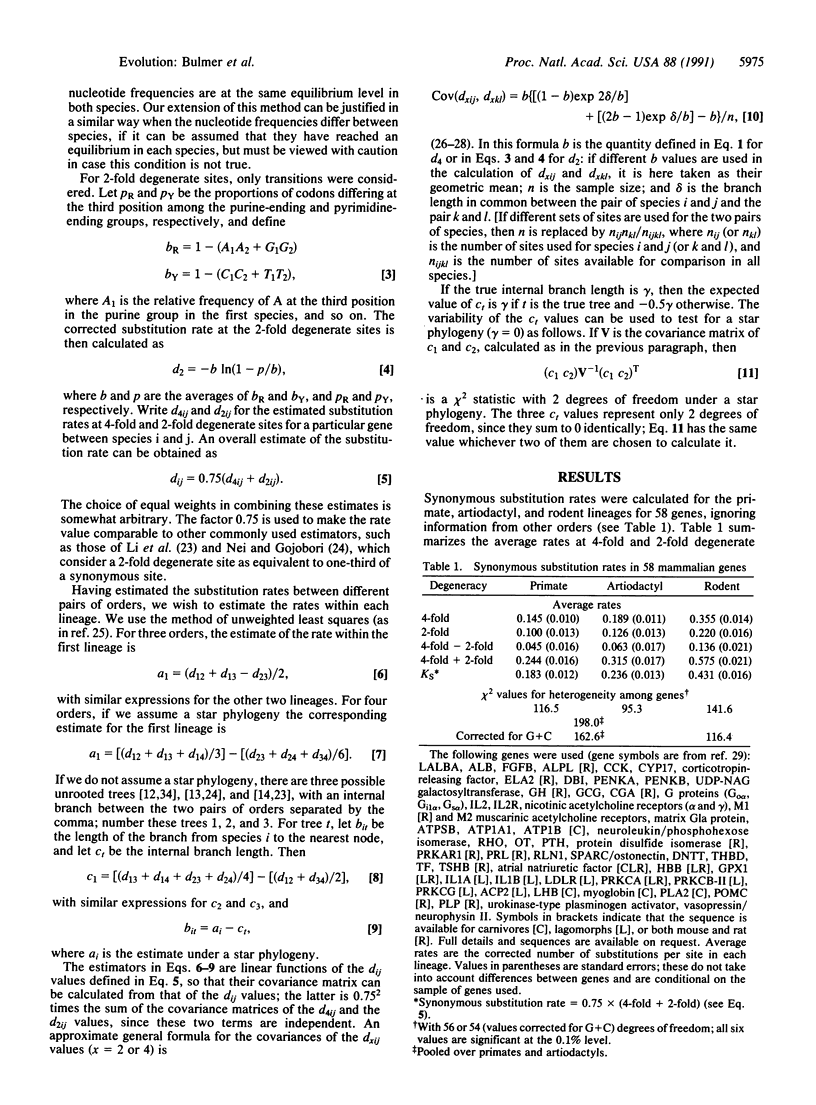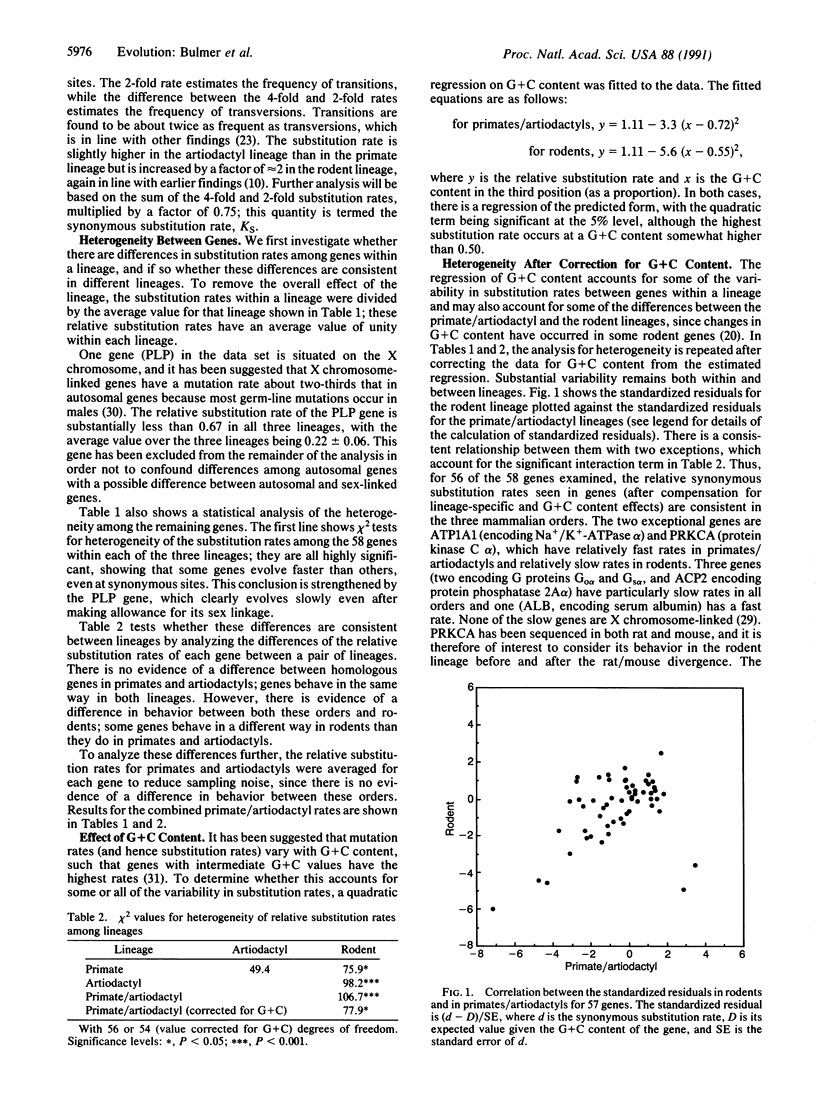Abstract
Synonymous substitution rates have been estimated for 58 genes compared among primates, artiodactyls, and rodents. Although silent sites might be expected to be neutral, there is substantial rate variation among genes within each lineage. Some of the rate variation is associated with G + C content: genes with intermediate G + C values have the highest rates. Nevertheless, considerable heterogeneity remains after correcting for G + C content. Synonymous substitution rates also vary among lineages, but the relative rates of genes are well conserved in different lineages. Certain genes have also been sequenced in a fourth order (lagomorph or carnivore), and these data have been used to investigate mammalian phylogeny. Data on lagomorphs are consistent with a star phylogeny, but there is evidence that carnivores and artiodactyls are sister groups. Genes sequenced in both rat and mouse suggest that the increased substitution rate in rodents has occurred since the rat/mouse divergence.
Full text
PDF




Selected References
These references are in PubMed. This may not be the complete list of references from this article.
- Benton M. J. Phylogeny of the major tetrapod groups: morphological data and divergence dates. J Mol Evol. 1990 May;30(5):409–424. doi: 10.1007/BF02101113. [DOI] [PubMed] [Google Scholar]
- Britten R. J. Rates of DNA sequence evolution differ between taxonomic groups. Science. 1986 Mar 21;231(4744):1393–1398. doi: 10.1126/science.3082006. [DOI] [PubMed] [Google Scholar]
- Bulmer M. Estimating the variability of substitution rates. Genetics. 1989 Nov;123(3):615–619. doi: 10.1093/genetics/123.3.615. [DOI] [PMC free article] [PubMed] [Google Scholar]
- Easteal S. Rate constancy of globin gene evolution in placental mammals. Proc Natl Acad Sci U S A. 1988 Oct;85(20):7622–7626. doi: 10.1073/pnas.85.20.7622. [DOI] [PMC free article] [PubMed] [Google Scholar]
- Easteal S. The pattern of mammalian evolution and the relative rate of molecular evolution. Genetics. 1990 Jan;124(1):165–173. doi: 10.1093/genetics/124.1.165. [DOI] [PMC free article] [PubMed] [Google Scholar]
- Gillespie J. H. The molecular clock may be an episodic clock. Proc Natl Acad Sci U S A. 1984 Dec;81(24):8009–8013. doi: 10.1073/pnas.81.24.8009. [DOI] [PMC free article] [PubMed] [Google Scholar]
- Gillespie J. H. Variability of evolutionary rates of DNA. Genetics. 1986 Aug;113(4):1077–1091. doi: 10.1093/genetics/113.4.1077. [DOI] [PMC free article] [PubMed] [Google Scholar]
- Ikemura T. Codon usage and tRNA content in unicellular and multicellular organisms. Mol Biol Evol. 1985 Jan;2(1):13–34. doi: 10.1093/oxfordjournals.molbev.a040335. [DOI] [PubMed] [Google Scholar]
- Kimura M. Molecular evolutionary clock and the neutral theory. J Mol Evol. 1987;26(1-2):24–33. doi: 10.1007/BF02111279. [DOI] [PubMed] [Google Scholar]
- Kimura M. Preponderance of synonymous changes as evidence for the neutral theory of molecular evolution. Nature. 1977 May 19;267(5608):275–276. doi: 10.1038/267275a0. [DOI] [PubMed] [Google Scholar]
- Koop B. F., Goodman M., Xu P., Chan K., Slightom J. L. Primate eta-globin DNA sequences and man's place among the great apes. Nature. 1986 Jan 16;319(6050):234–238. doi: 10.1038/319234a0. [DOI] [PubMed] [Google Scholar]
- Lewontin R. C. Inferring the number of evolutionary events from DNA coding sequence differences. Mol Biol Evol. 1989 Jan;6(1):15–32. doi: 10.1093/oxfordjournals.molbev.a040532. [DOI] [PubMed] [Google Scholar]
- Li W. H. A statistical test of phylogenies estimated from sequence data. Mol Biol Evol. 1989 Jul;6(4):424–435. doi: 10.1093/oxfordjournals.molbev.a040560. [DOI] [PubMed] [Google Scholar]
- Li W. H., Gouy M., Sharp P. M., O'hUigin C., Yang Y. W. Molecular phylogeny of Rodentia, Lagomorpha, Primates, Artiodactyla, and Carnivora and molecular clocks. Proc Natl Acad Sci U S A. 1990 Sep;87(17):6703–6707. doi: 10.1073/pnas.87.17.6703. [DOI] [PMC free article] [PubMed] [Google Scholar]
- Li W. H., Tanimura M., Sharp P. M. An evaluation of the molecular clock hypothesis using mammalian DNA sequences. J Mol Evol. 1987;25(4):330–342. doi: 10.1007/BF02603118. [DOI] [PubMed] [Google Scholar]
- Li W. H., Tanimura M. The molecular clock runs more slowly in man than in apes and monkeys. Nature. 1987 Mar 5;326(6108):93–96. doi: 10.1038/326093a0. [DOI] [PubMed] [Google Scholar]
- Li W. H., Wu C. I., Luo C. C. A new method for estimating synonymous and nonsynonymous rates of nucleotide substitution considering the relative likelihood of nucleotide and codon changes. Mol Biol Evol. 1985 Mar;2(2):150–174. doi: 10.1093/oxfordjournals.molbev.a040343. [DOI] [PubMed] [Google Scholar]
- Miyata T., Hayashida H., Kuma K., Mitsuyasu K., Yasunaga T. Male-driven molecular evolution: a model and nucleotide sequence analysis. Cold Spring Harb Symp Quant Biol. 1987;52:863–867. doi: 10.1101/sqb.1987.052.01.094. [DOI] [PubMed] [Google Scholar]
- Miyata T., Yasunaga T., Nishida T. Nucleotide sequence divergence and functional constraint in mRNA evolution. Proc Natl Acad Sci U S A. 1980 Dec;77(12):7328–7332. doi: 10.1073/pnas.77.12.7328. [DOI] [PMC free article] [PubMed] [Google Scholar]
- Mouchiroud D., Gautier C., Bernardi G. The compositional distribution of coding sequences and DNA molecules in humans and murids. J Mol Evol. 1988;27(4):311–320. doi: 10.1007/BF02101193. [DOI] [PubMed] [Google Scholar]
- Nei M., Gojobori T. Simple methods for estimating the numbers of synonymous and nonsynonymous nucleotide substitutions. Mol Biol Evol. 1986 Sep;3(5):418–426. doi: 10.1093/oxfordjournals.molbev.a040410. [DOI] [PubMed] [Google Scholar]
- Nei M., Jin L. Variances of the average numbers of nucleotide substitutions within and between populations. Mol Biol Evol. 1989 May;6(3):290–300. doi: 10.1093/oxfordjournals.molbev.a040547. [DOI] [PubMed] [Google Scholar]
- Nei M., Stephens J. C., Saitou N. Methods for computing the standard errors of branching points in an evolutionary tree and their application to molecular data from humans and apes. Mol Biol Evol. 1985 Jan;2(1):66–85. doi: 10.1093/oxfordjournals.molbev.a040333. [DOI] [PubMed] [Google Scholar]
- Saccone C., Pesole G., Preparata G. DNA microenvironments and the molecular clock. J Mol Evol. 1989 Nov;29(5):407–411. doi: 10.1007/BF02602910. [DOI] [PubMed] [Google Scholar]
- Sharp P. M., Li W. H. An evolutionary perspective on synonymous codon usage in unicellular organisms. J Mol Evol. 1986;24(1-2):28–38. doi: 10.1007/BF02099948. [DOI] [PubMed] [Google Scholar]
- Sharp P. M., Li W. H. On the rate of DNA sequence evolution in Drosophila. J Mol Evol. 1989 May;28(5):398–402. doi: 10.1007/BF02603075. [DOI] [PubMed] [Google Scholar]
- Shields D. C., Sharp P. M., Higgins D. G., Wright F. "Silent" sites in Drosophila genes are not neutral: evidence of selection among synonymous codons. Mol Biol Evol. 1988 Nov;5(6):704–716. doi: 10.1093/oxfordjournals.molbev.a040525. [DOI] [PubMed] [Google Scholar]
- Tajima F., Nei M. Estimation of evolutionary distance between nucleotide sequences. Mol Biol Evol. 1984 Apr;1(3):269–285. doi: 10.1093/oxfordjournals.molbev.a040317. [DOI] [PubMed] [Google Scholar]
- Wolfe K. H., Sharp P. M., Li W. H. Mutation rates differ among regions of the mammalian genome. Nature. 1989 Jan 19;337(6204):283–285. doi: 10.1038/337283a0. [DOI] [PubMed] [Google Scholar]
- Wu C. I., Li W. H. Evidence for higher rates of nucleotide substitution in rodents than in man. Proc Natl Acad Sci U S A. 1985 Mar;82(6):1741–1745. doi: 10.1073/pnas.82.6.1741. [DOI] [PMC free article] [PubMed] [Google Scholar]


